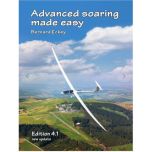Getting to the Core of Clouds

The art of thermalling begins well before you even start climbing, and can be divided into 2 simple phases: First of all you must locate the general area of the core; then you must find and keep the sailplane in the strongest part. Seems obvious, but to have a successful flight we must start with one of the objectives and work backward. I’ll give it my best to describe this below, once mastered, it becomes immensely satisfying!
As you glide to the area of good lift, you should be carefully studying all the clues, such as cumulus development ahead, or on blue days, searching for signs of thermals leaving the ground.
Understanding clouds are perhaps one of the most important skills in gliding. Generally, the larger the size and depth of the cumulus, the more studying, and searching are required. On a day with small cumulus, the lift area should be small and easy to locate. A very large cloud such as cumulonimbus, however, may have many cores and extensive searching may be necessary.
Climbs come in all sorts of shapes and sizes. One thing for sure is with irregularly shaped climbs, do your best to center on roughly the core, and just accept it won’t be perfect. In strong conditions, get the glider to the core – asap, do not be afraid to bank it over. If you lose the core, widen out the turn to an extended search area. If it is going to take too long to center, equally don’t be afraid to leave, there’s always another climb in front of you. Finally, centralize the controls and fly with a touch of top rudder. This reduces drag and gives the wings a higher angle of attack, therefore faster climb.
I’ve said it before, but one must have a very good vario system! If you’re not sure about it, ask one of the top pilots in your club to take your glider for an afternoon flight to get feedback. Seat of the pants will tell you more and should not be underestimated. Only climb in what FEELS like SOLID lift for the day. Time circling should be spent planning your next track, then plan ‘B’ and even ‘C’ options.
So what do I look for in a cloud? As previously mentioned, it depends on the size – so let’s give it a go!
First of all, it’s important to start analyzing the cloud from far out, is it shallow, mid-sized, or large? I start thinking about the wind, where is it coming from? If I am higher I’ll aim more central, if I’m lower, I’ll aim for more upwind of the cloud area. Typically, during the day you’ll get a feeling for where you found the last climbs, this should be a target of concentration as you approach.
Shallow Cumulus
These conditions are ideal, as cloud distribution is low, and ground heating is increased. Thermals can cycle quickly, often the best climbs are found in the blue or early developing wisps. Start looking for areas that are clearly working, there is no point in wasting time anywhere else. If cloud centers fail, look for movement at the edges, by movement I mean the edges appearing to curl or have a circular motion. Another really good sign of quality lift is when rainbow colors appear in these areas, hard to describe more than that, but once you learn this, you’ll see it often. Use caution though, if this cloud is showing signs of decay, look to sides – especially up or downwind in 10kts or more wind.
Mid-sized Cumulus
Occupies a larger proportion of the sky, perhaps 4/8ths. Generally, when below half convection look for the cores under edges of clouds that are still in sunlight. It’s always a good idea to stay high, so look for the darkest & most defined concave shape to them. This shows the strongest lift as it pushes up into the cloud and hasn’t got time to condense to a flat base like the rest of the cloud. Ever noticed those ‘daggy’ bits that hang down in the middle? Typically go straight to them too, they indicate signs of stronger than average lift.
These are complex clouds with so many variables, but when there is a step in cloudbase, search under the higher part of the cloud. Be very wary when there is no sun on the ground, this sort of cloud can cause ‘spread out’ of the cloud, blocking off the heat to the ground. Especially when low, you’ll have to watch for cycling of conditions. You may need to stop in something weaker to get back to a third of the convection height to get back in contact with the clouds again.
Large Cumulus
Normally indicated by an unstable airmass in the late afternoon – areas of overdevelopment can be expected. More than 4/8ths sky covered. Shadow alone is unlikely to starve the thermal because large cu suck air upwards. Crucial to study at great lengths because of large lift and sink areas. Exploding tops should indicate the general area of rising energy. Same techniques as moderate cu to be used plus, look for climbs against the down-wind edges, and fly under cloud domes, like the concave description above.
You’ll never stop learning about clouds, they are inherently interesting and forever changing, guess it’s part of the reason why this wonderful sport never ceases to fail at rewarding us or having us scratch our heads yet again!









